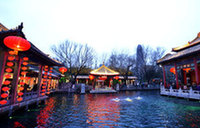Daming Lake reflects the memories of Jinan residents
|
With a ring of ancient lakeside pavilions, residences and temples, the Daming Lake is Jinan's top tourist site. Ju Chuanjiang / China Daily |
Beiji Temple, built in 1280 on a 7-meter-high stone stage on the north bank, is the place to worship the water god, a gaily painted mud statue resembling an emperor. It is also the best place to enjoy the lake view. In the main hall of the temple, there are valuable Song Dynasty frescoes with the complete story of how the water god grew up.
 |
|
Top 10 most profitable tourist cities during Spring Festival |
Between the two temples is the Huibo Building, or wave-converging building, which is perched on a high solid stone base as well. There is a water canal, equipped with a water sluice, flowing through the bottom of the base. It is the only outlet for the springwater of the lake, called Xiaobei Gate, or small north gate. The canal connects the origin of the Xiaoqing River about 3 kilometers away in the north by an open watercourse of 5 meters in width.
The Xiaobei Gate is a crucial water-control project for old Jinan. It keeps springwater in the city during droughts and drains off the water in rainy seasons.
Standing on the Huibo Building, you can see two isolated cone-shaped hills called Queshan and Huashan several kilometers away on your left and right respectively. The Xiaoqing River flows between the two hills to the northeast like a jade-green silk belt.
The two hills, both 200 meters high and covered with thick vegetation, look like two guards clad in green defending the northern suburb of the city.
Two ancient gardens are located in the east and south of the lake. The one on the east was built in 1792 and is of South China style. The southern one was built in 1909, mixing some Western architectural elements in its Chinese style, and was used as part of the provincial library until the "cultural revolution" (1966-76).
The ancient wood-brick buildings surrounding the lake, built from the Yuan Dynasty (1271-1368) to the Qing Dynasty (1644-1911), integrate well with the natural landscape. The Thousand Buddha Hill embracing the south of Jinan is like a screen shaping the city's skyline with greenish curves, which is reflected in the mirror-like lake surface on sunny days.
Many Jinan people play beside the lake during their childhood days, go on boat rides with their dates when they grow up and stroll around the lake after retirement. Similar memories hold the communities together. The lake makes Jinan a big family, as many locals would tell you.
Ju Chuanjiang contributed to this story.
















